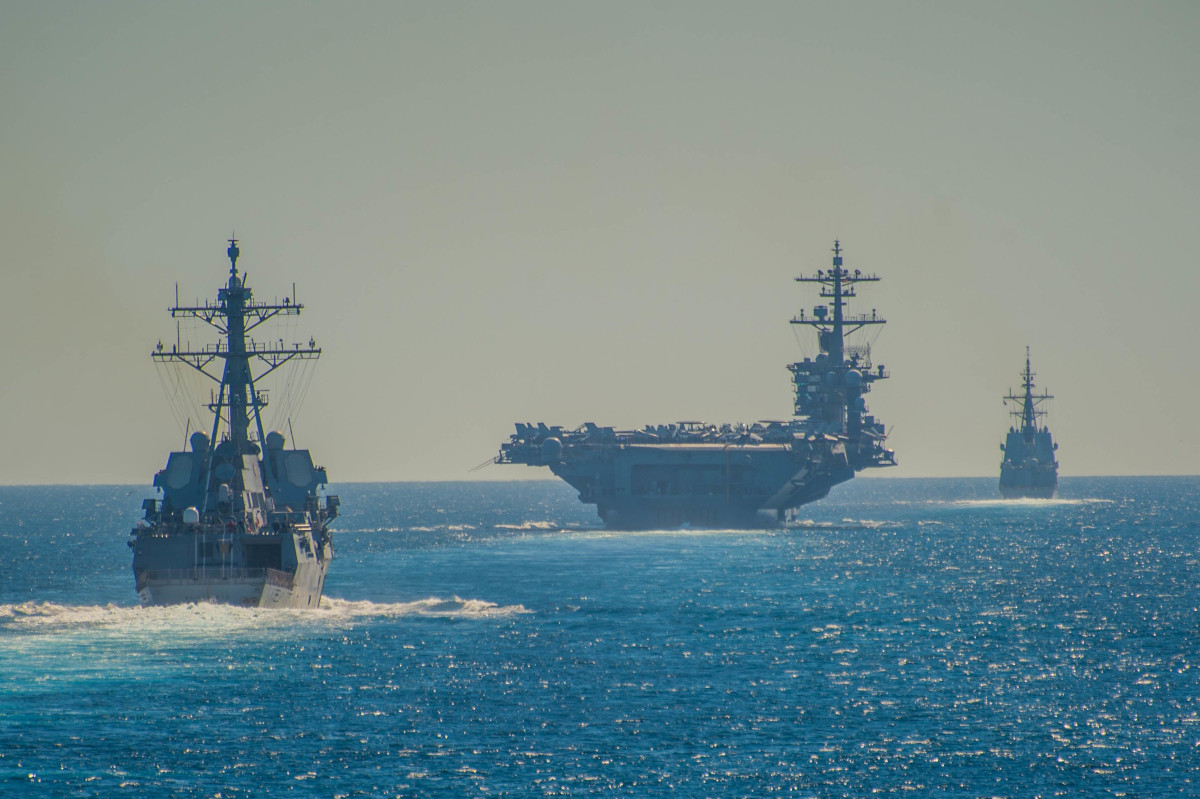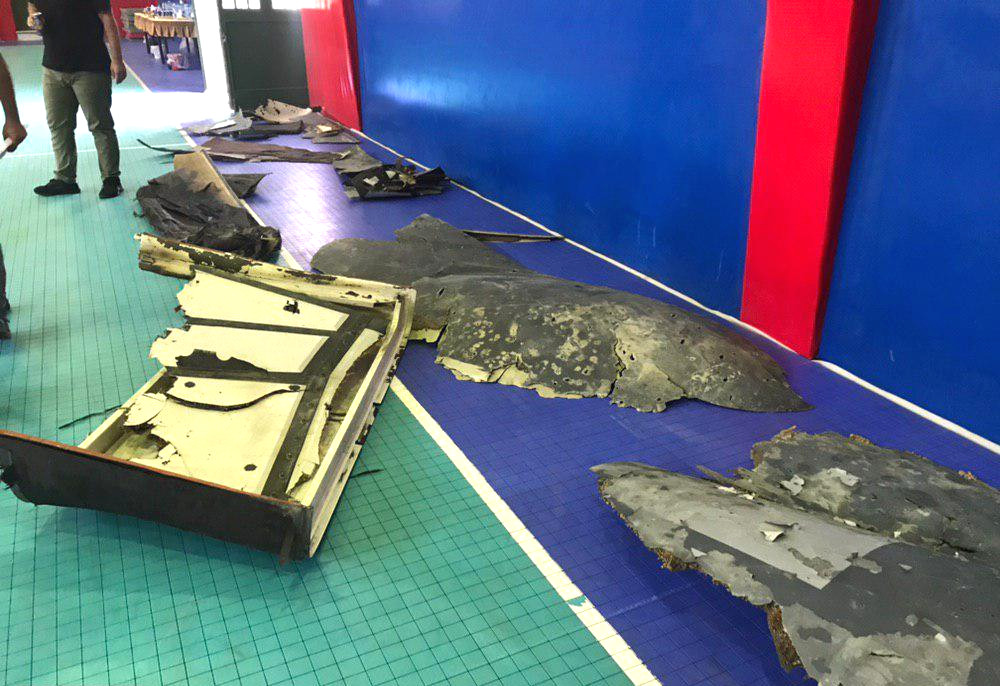U.S. President Donald Trump says American forces were “cocked and loaded” to strike targets in Iran overnight, but that he called off the operation because he felt estimates that there would be approximately 150 Iranian casualties was not a proportional response to the loss of an unmanned aircraft. This comes as Iran, which admits to shooting down the U.S. Navy RQ-4 Broad Area Maritime Surveillance-Demonstrator drone, or BAMS-D, says it refrained from destroying a manned aircraft that it claims violated its airspace around the same time.
Trump explained his decision in a series of Tweets on June 21, 2019. In doing so, he confirmed a story earlier in the day from The New York Times, which had first reported on the abrupt shift in plans, citing anonymous sources. Other outlets, citing other unnamed individuals, had already added weight to the report that the U.S. military had been about to strike Iran, before receiving an order to stand down.
“We were cocked & loaded to retaliate last night on 3 different sights when I asked, how many will die. 150 people, sir, was the answer from a General,” Trump wrote on Twitter. “10 minutes before the strike I stopped it, not proportionate to shooting down an unmanned drone. I am in no hurry, our Military is rebuilt, new, and ready to go, by far the best in the world. Sanctions are biting & more added last night.”
Trump later qualified the statements in an interview with NBC‘s “Meet The Press,” according to an excepted published on June 21, 2019. The President said that he had not actually given final approval for the operation.
“No, but they would have been pretty soon, and things would have happened to a point where you would not turn back, you could not turn back,” Trump told Chuck Todd in the interview when asked about whether planes were already in the air heading toward Iran. “Nothing was green-lighted until the very end because things change.”
Trump did not specify what targets U.S. forces planned to strike. Newsweek had reported earlier that one of them was a Russian-made S-125 surface-to-air missile system site. An unnamed Pentagon official had told that outlet that the United States believed this weapon was employed to shoot down the BAMS-D. Iran has publicly said that it used the 3rd Khordad, a road-mobile variant of the country’s Raad, or Thunder, a locally produced analog to the Russian SA-11 Buk.
We also don’t know what U.S. assets might have been alerted for the operation. Since May 2019, the United States has sent a succession of additional aircraft, ships, and ground units to the region, including the Nimitz-class aircraft carrier USS Abraham Lincoln and her associated strike group and four B-52 bombers. The Abraham Lincoln Strike Group includes the Ticonderoga-class cruiser USS Leyte Gulf, five Arleigh Burke-class destroyers, and a Los Angeles-class attack submarine, all of which can fire Tomahawk Land Attack Missiles. Additional Tomahawk-armed submarines may also be within range. The B-52s could also conduct stand-off strikes using air-launched cruise missiles, such as the AGM-158 Joint Air-to-Surface Standoff Missile (JASSM).
In April 2018, the United States, along with France and the United Kingdom, launched a series of strikes against targets in Syria using a mixture of sea- and air-launched cruise missiles from a similar mix of launch platforms. Online plane spotters did pick up at least two of the four B-52s in the region, using the callsigns Grimm 21 and 23, flying over the Persian Gulf at around 7:40 AM local time, which was reportedly after the final decision to stand down came through.
There are also still outstanding questions about the exact timeline of events. Newsweek reported that crews onboard U.S. Navy ships in the region were only alerted of the impending mission “within an hour” of when it was supposed to occur. It is unclear how far in advance American forces had actually been preparing to conduct the strikes given reports of how long the decision-making process appeared to last and Trump’s statements that he never actually authorized them in the end.

In addition, it seems hard to believe that he would not have been informed about the potential casualties so late in the decision-making process, though that would not necessarily have precluded Trump from asking the question again later on and making a snap decision to abort the mission. It is also unclear whether these were projected Iranian military or civilian casualties, or a mix thereof. ABC News, citing anonymous sources, says U.S. officials had worried about possible collateral damage from the strikes. There is no indication that the targets themselves were of a civilian nature, such as government buildings, though.
There are separate, unconfirmed reports, that Trump had received some additional information about the situation that ultimately swayed him not to launch the strikes. This includes possible intelligence that portions of Iran’s leadership were infuriated by the Islamic Revolutionary Guard Corps’ (IRGC) decision to shoot down the drone, pointing to potential friction within the country’s various governing bodies over how to respond to American policies.
But there is no question that the matter of proportionality would have been a factor in the decision-making process, something The War Zone highlighted during its coverage yesterday of the shootdown and possible reactions to it. The loss of a drone meant that there were no U.S. casualties. So, it would be difficult not to see subsequent U.S. strikes that killed Iranians as an escalation and one that would be highly likely to provoke a response in kind from the regime in Tehran.

In a particularly interesting development, the Iranians themselves have now outlined a similar threshold in their own decision to bring down the BAMS-D. Brigadier General Amir Ali Hajizadeh, head of the IRGC’s Aerospace Forces, who command that conducted the shootdown, claimed that a manned aircraft had also violated Iran’s airspace at the same time as the drone, but that his forces refrained from destroying it.
“With the U.S. drone in the region there was also an American P-8 plane with 35 people on board,” Hajizadeh said, according to the semi-official Tasnim News Agency. “This plane also entered our airspace and we could have shot it down, but we did not.”
It is not clear what plane he was referring to exactly. The U.S. Navy’s P-8A Poseidon maritime patrol aircraft does not carry a crew of 35 individuals, but The Washington Post has reported, citing an unnamed U.S. defense official, that a P-8 was flying in the same general area at the time. It seems very possible that Hajizadeh simply misspoke.
The presence of the Poseidon would also explain the source of video and images that the Pentagon has subsequently released showing the shootdown that appeared to have been taken by another aircraft. The P-8 also has impressive electronic support measures and electronic intelligence capabilities, which could have helped in identifying the specific weapon the Iranians employed and geo-locating the launch site.

Further analysis of the imagery that the U.S. government has released so far also lends more weight to the American position that the BAMS-D was flying in international airspace and came down in international waters. It also indicates that that P-8 was flying slightly closer to the Iranian coastline than the drone, though it was also in international airspace.
At the same time, Iran has now displayed parts of the BAMS-D wreckage, seen in the pictures below, which it claims it recovered in Iranian territorial waters, though it has not released any imagery or other details about the retrieval process to support that assertion.
Regardless, Hajizadeh was clearly seeking to convey the message that Iran could have killed Americans, but deliberately decided not to, instead choosing to make a statement about the country’s resolve without causing casualties.





Unfortunately, despite Iran and the United States now both having publicly declared that they made choices to avoid military action that could have led to casualties and potentially sparked a larger conflict, there no guarantee the U.S. government might not choose to follow through on a military response in the future. Various assets, including the Leyte Gulf, are reportedly now on alert for a possible new tasking in the next 72 hours, according to Newsweek. It is possible that, as with the Iranians, the revelation that the United States could have struck, but didn’t, could serve as a signal of the U.S. government’s preparedness to act, but actual desire to de-escalate the situation.
Initial reports had suggested that Trump had called on Iran to seek a diplomatic avenue to resolving escalating regional tensions, via Oman, or risk an American military response, but that the Iranians rebuffed this offer. A spokesperson for Iran’s Supreme National Security Council subsequently denied that there had been any such backchannel messaging and Trump made no mention of this in his Tweets.
Iran’s supreme leader, the Ayatollah Ali Khamenei, has previously publicly rejected any prospect of negotiating with the Trump Administration. Trump himself has publicly said that he favors talks, but that neither side was ready to do so.
In his Tweets, Trump also said that he had chosen to implement additional sanctions on Iran over the incident, which was another potential course of action The War Zone had identified yesterday, but the U.S. government has not yet confirmed that this is the case or what those new economic restrictions might cover. The Trump Administration has adopted a policy of “maximum pressure” against Iran that has already included various efforts to isolate Tehran diplomatically and economically.
The U.S. government’s stated objectives in doing this has been to goad Iran into abandoning a host of policies, including any potential ambitions of developing a nuclear weapon, support for international terrorist and militant groups, and more. Clearly, at least so far, this has not worked out as planned. A spokesman for Iran’s President, Hassan Rouhani, has since called upon the United States to ease existing sanctions as the only means to averting a conflict.
Whether or not Congress will, or can, take steps to intervene and block potential military action against Iran also remains to be seen. Various legislators have come out in favor of strikes, or other “measured responses,” as well as called for caution and restraint, largely along party lines. The revelation that the Trump Administration was prepared to conduct strikes without seeking Congressional approval has also prompted criticism that the President is exceeding his authority.
The coming days could be absolutely critical in determining whether the situation continues to escalate or whether Iran and the United States begin finding ways to ease tensions that have been rapidly building for more than a month now. Late on June 20, 2019, the Federal Aviation Administration barred U.S.-registered aircraft from flying over the Persian Gulf and Gulf of Oman due to the potential for sudden developments that might “place commercial flights at risk.” The U.S. military had previously pointed out the potential risks to commercial aviation from Iran’s decision to shoot down the BAMS-D.
There are still similar concerns about possible threats to commercial shipping in the region following attacks on tankers in the Gulf of Oman, including limpet mine attacks on a pair of ships earlier in June. The U.S. government blames Iran for these incidents, as well, though Iran has denied any responsibility. On June 21, 2019, India announced that it would deploy warships to the region to safeguard its shipping interests and the United Kingdom had previously announced it was sending a contingent of Royal Marines to the area to bolster its force protection posture.
With U.S. military assets in the region still reportedly poised to strike, it may only be a matter of hours before we will know for sure how the Trump Administration has decided to proceed.
Contact the author: joe@thedrive.com
